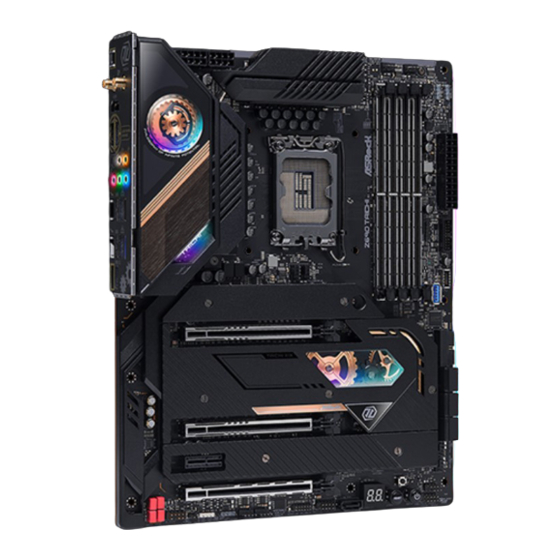
Summarization of Contents
Chapter 2 Software and Utilities Operation
2.1 Auto Driver Installer (ADI)
Guides on using the automatic driver installation tool for system drivers.
2.1.1 Installing Drivers for the First Time
Step-by-step instructions for installing drivers using the Auto Driver Installer.
2.1.2 Updating Drivers
Process for updating system drivers via the ASRock website.
2.2 ASRock Live Update & APP Shop
Information on ASRock's utility for downloading software and system updates.
2.2.1 Installing ASRock Live Update & APP Shop
Instructions for downloading and installing the ASRock Live Update & APP Shop utility.
2.2.2 UI Overview
Explanation of the user interface elements and layout of the APP Shop.
2.2.3 Apps
Details on browsing, installing, and managing applications within the APP Shop.
2.2.4 BIOS & Drivers
Guide to updating BIOS and drivers through the ASRock Live Update & APP Shop.
2.2.5 Setting
Configuration options for the ASRock Live Update & APP Shop, including auto-run and language.
2.3 ASRock Motherboard Utility (A-Tuning)
Overview of the A-Tuning utility for system monitoring and control.
2.3.1 Installing ASRock Motherboard Utility (A-Tuning)
Instructions for downloading and installing the ASRock Motherboard Utility (A-Tuning).
2.3.2 Using ASRock Motherboard Utility (A-Tuning)
Explanation of the features and sections within the A-Tuning utility.
2.4 ASRock Motherboard Utility (Phantom Gaming Tuning)
Details on the Phantom Gaming Tuning utility for system control.
2.4.1 Installing ASRock Motherboard Utility (Phantom Gaming Tuning)
Steps to download and install the Phantom Gaming Tuning utility.
2.4.2 Using ASRock Motherboard Utility (Phantom Gaming Tuning)
Guide to the functionalities and sections of the Phantom Gaming Tuning utility.
2.5 ASRock Polychrome SYNC
Introduction to the lighting control utility for RGB customization.
2.5.1 Connecting the LED Strip
Instructions for connecting RGB LED strips to the motherboard header.
2.5.2 Connecting the Addressable RGB LED Strip
Guide on connecting addressable RGB LED strips to the motherboard.
2.5.3 Installing ASRock Polychrome SYNC Utility
Steps to download and install the ASRock Polychrome SYNC utility for RGB control.
2.6 Nahimic Audio
Overview of the Nahimic audio software for enhanced sound performance.
Chapter 3 UEFI SETUP UTILITY
3.1 Introduction
General introduction to the ASRock UEFI BIOS utility and its features.
3.1.1 Entering BIOS Setup
Instructions on how to access the UEFI BIOS setup utility.
3.1.2 EZ Mode
Overview and navigation of the EZ Mode interface in the UEFI BIOS.
3.1.3 Advanced Mode
Introduction to the Advanced Mode for comprehensive BIOS settings.
3.1.4 UEFI Menu Bar
Description of the main menu bar options within the UEFI BIOS.
3.1.5 Navigation Keys
Explanation of keyboard navigation keys for the UEFI BIOS utility.
3.2 Main Screen (Advanced Mode)
Details on the system overview displayed on the Main screen in Advanced Mode.
3.3 OC Tweaker Screen
Guide to configuring overclocking settings for CPU and memory.
3.4 Advanced Screen
Overview of the Advanced screen and its sub-configuration sections.
3.4.1 CPU Configuration
Detailed settings for CPU features, cores, and power management.
3.4.2 Chipset Configuration
Configuration options for the motherboard chipset and integrated devices.
3.4.3 Storage Configuration
Settings for SATA controllers, storage modes, and VMD configuration.
3.4.4 Intel(R) Thunderbolt
Configuration options for Intel Thunderbolt support and boot behavior.
3.4.5 Super IO Configuration
Settings related to Super IO functions, such as PS/2 ports.
3.4.6 ACPI Configuration
Power management settings including Suspend to RAM and wake-up options.
3.4.7 USB Configuration
Settings for USB support, legacy support, and XHCI hand-off.
3.4.8 Trusted Computing
Configuration for security features like TPM and Secure Boot.
3.5 Tools
Access to utility tools like ASRock Polychrome RGB, Instant Flash, etc.
3.6 Hardware Health Event Monitoring Screen
Monitoring system hardware status, including temperatures and fan speeds.
3.7 Security Screen
Settings for user and supervisor passwords, and Secure Boot.
3.8 Boot Screen
Configuration of boot order, fast boot, and CSM settings.
3.9 Exit Screen
Options for saving changes, discarding changes, and loading defaults.







Need help?
Do you have a question about the H770 Series and is the answer not in the manual?
Questions and answers